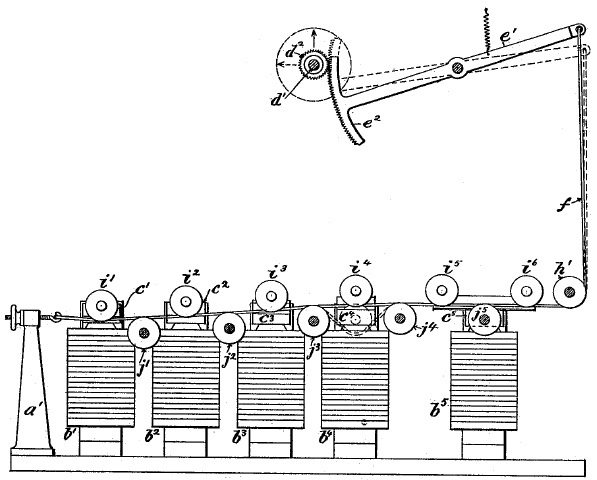Mechanical Digital to Analog Converter – US Patent 529630
It’s 1887. The only electrical components you have access to are electromagnets. And you want to build a digital to analog converter. What do you do?
The answer is simple. Run a string along the ends of a series of electromagnets, and arrange pulleys connected to these magnets so that each successive magnet pulls twice the length of string when activated. Here is the schematic from the original patent:

The operation is fairly straightforward. The five electromagnets are arranged at the bottom, with bit 0 at the left and bit 4 at the right. The wheels above the string are attached to the magnets, and pull the string down when the magnet is activated. The wheels below the string are fixed. In the diagram, the magnet for bit 3 (second from the right) shows the state of the string in the activated state with dotted lines. Each magnet pulls down the string by double the amount of the previous magnet.
One interesting point is that the electromagnets of the 1870s still weren’t particularly powerful or capable (these days you can get more powerful magnets as toys), and the consequences of that manifest in the design of this device. If we assume that magnet for bit 0 moves through a distance of 1/16 of an inch (approx 1.6 mm), then it means that the magnet for bit 3 needs to move through a distance of 1/2 inch (approx. 12.7 mm). But at this point, we have hit the limit of the distance over which our weak magnets can perform. The magnet for bit 4 thus doubles the distance not through doubling the length of motion, but by employing two wheels which deflect the string by the same amount in two locations. This 5-bit D/A converter is thus on the cutting edge of what could be achieved in the 1870s.
I don’t know what kind of data rate was possible with this device, but it clearly isn’t going to be enough to create a 19th-century version of the Sound Blaster. In fact, the reason this D/A converter was invented was for handling the 5-bit encoding of the world’s first binary electronic communication system, the 5-bit Baudot telegraph.
If you feel like making your own, the parts are all available on Amazon:
Related Posts
Tweet




